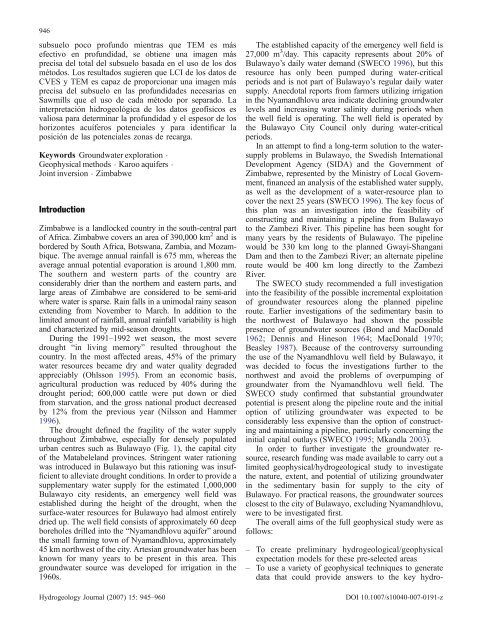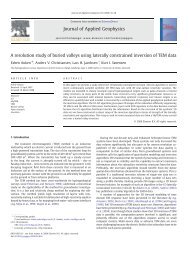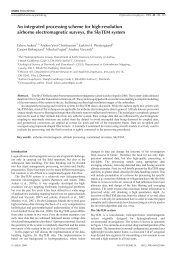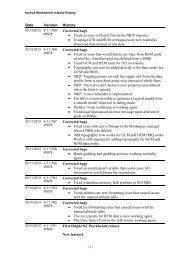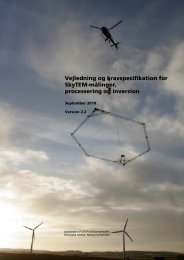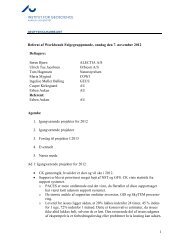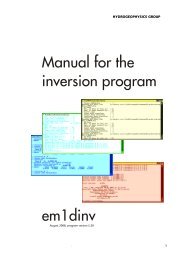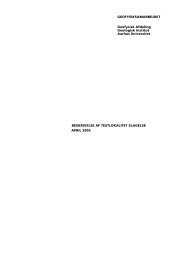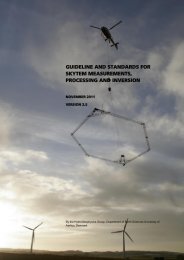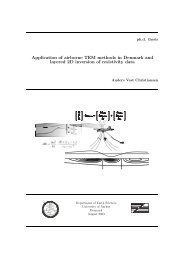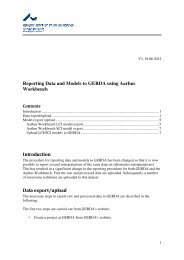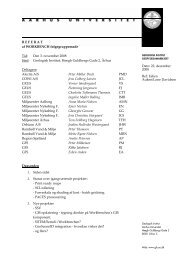Geophysical and hydrogeologic investigation of groundwater in the ...
Geophysical and hydrogeologic investigation of groundwater in the ...
Geophysical and hydrogeologic investigation of groundwater in the ...
- No tags were found...
Create successful ePaper yourself
Turn your PDF publications into a flip-book with our unique Google optimized e-Paper software.
946subsuelo poco pr<strong>of</strong>undo mientras que TEM es másefectivo en pr<strong>of</strong>undidad, se obtiene una imagen másprecisa del total del subsuelo basada en el uso de los dosmétodos. Los resultados sugieren que LCI de los datos deCVES y TEM es capaz de proporcionar una imagen másprecisa del subsuelo en las pr<strong>of</strong>undidades necesarias enSawmills que el uso de cada método por separado. La<strong>in</strong>terpretación hidrogeológica de los datos ge<strong>of</strong>ísicos esvaliosa para determ<strong>in</strong>ar la pr<strong>of</strong>undidad y el espesor de loshorizontes acuíferos potenciales y para identificar laposición de las potenciales zonas de recarga.Keywords Groundwater exploration .<strong>Geophysical</strong> methods . Karoo aquifers .Jo<strong>in</strong>t <strong>in</strong>version . ZimbabweIntroductionZimbabwe is a l<strong>and</strong>locked country <strong>in</strong> <strong>the</strong> south-central part<strong>of</strong> Africa. Zimbabwe covers an area <strong>of</strong> 390,000 km 2 <strong>and</strong> isbordered by South Africa, Botswana, Zambia, <strong>and</strong> Mozambique.The average annual ra<strong>in</strong>fall is 675 mm, whereas <strong>the</strong>average annual potential evaporation is around 1,800 mm.The sou<strong>the</strong>rn <strong>and</strong> western parts <strong>of</strong> <strong>the</strong> country areconsiderably drier than <strong>the</strong> nor<strong>the</strong>rn <strong>and</strong> eastern parts, <strong>and</strong>large areas <strong>of</strong> Zimbabwe are considered to be semi-aridwhere water is sparse. Ra<strong>in</strong> falls <strong>in</strong> a unimodal ra<strong>in</strong>y seasonextend<strong>in</strong>g from November to March. In addition to <strong>the</strong>limited amount <strong>of</strong> ra<strong>in</strong>fall, annual ra<strong>in</strong>fall variability is high<strong>and</strong> characterized by mid-season droughts.Dur<strong>in</strong>g <strong>the</strong> 1991–1992 wet season, <strong>the</strong> most severedrought “<strong>in</strong> liv<strong>in</strong>g memory” resulted throughout <strong>the</strong>country. In <strong>the</strong> most affected areas, 45% <strong>of</strong> <strong>the</strong> primarywater resources became dry <strong>and</strong> water quality degradedappreciably (Ohlsson 1995). From an economic basis,agricultural production was reduced by 40% dur<strong>in</strong>g <strong>the</strong>drought period; 600,000 cattle were put down or diedfrom starvation, <strong>and</strong> <strong>the</strong> gross national product decreasedby 12% from <strong>the</strong> previous year (Nilsson <strong>and</strong> Hammer1996).The drought def<strong>in</strong>ed <strong>the</strong> fragility <strong>of</strong> <strong>the</strong> water supplythroughout Zimbabwe, especially for densely populatedurban centres such as Bulawayo (Fig. 1), <strong>the</strong> capital city<strong>of</strong> <strong>the</strong> Matabelel<strong>and</strong> prov<strong>in</strong>ces. Str<strong>in</strong>gent water ration<strong>in</strong>gwas <strong>in</strong>troduced <strong>in</strong> Bulawayo but this ration<strong>in</strong>g was <strong>in</strong>sufficientto alleviate drought conditions. In order to provide asupplementary water supply for <strong>the</strong> estimated 1,000,000Bulawayo city residents, an emergency well field wasestablished dur<strong>in</strong>g <strong>the</strong> height <strong>of</strong> <strong>the</strong> drought, when <strong>the</strong>surface-water resources for Bulawayo had almost entirelydried up. The well field consists <strong>of</strong> approximately 60 deepboreholes drilled <strong>in</strong>to <strong>the</strong> “Nyam<strong>and</strong>hlovu aquifer” around<strong>the</strong> small farm<strong>in</strong>g town <strong>of</strong> Nyam<strong>and</strong>hlovu, approximately45 km northwest <strong>of</strong> <strong>the</strong> city. Artesian <strong>groundwater</strong> has beenknown for many years to be present <strong>in</strong> this area. This<strong>groundwater</strong> source was developed for irrigation <strong>in</strong> <strong>the</strong>1960s.Hydrogeology Journal (2007) 15: 945–960The established capacity <strong>of</strong> <strong>the</strong> emergency well field is27,000 m 3 /day. This capacity represents about 20% <strong>of</strong>Bulawayo’s daily water dem<strong>and</strong> (SWECO 1996), but thisresource has only been pumped dur<strong>in</strong>g water-criticalperiods <strong>and</strong> is not part <strong>of</strong> Bulawayo’s regular daily watersupply. Anecdotal reports from farmers utiliz<strong>in</strong>g irrigation<strong>in</strong> <strong>the</strong> Nyam<strong>and</strong>hlovu area <strong>in</strong>dicate decl<strong>in</strong><strong>in</strong>g <strong>groundwater</strong>levels <strong>and</strong> <strong>in</strong>creas<strong>in</strong>g water sal<strong>in</strong>ity dur<strong>in</strong>g periods when<strong>the</strong> well field is operat<strong>in</strong>g. The well field is operated by<strong>the</strong> Bulawayo City Council only dur<strong>in</strong>g water-criticalperiods.In an attempt to f<strong>in</strong>d a long-term solution to <strong>the</strong> watersupplyproblems <strong>in</strong> Bulawayo, <strong>the</strong> Swedish InternationalDevelopment Agency (SIDA) <strong>and</strong> <strong>the</strong> Government <strong>of</strong>Zimbabwe, represented by <strong>the</strong> M<strong>in</strong>istry <strong>of</strong> Local Government,f<strong>in</strong>anced an analysis <strong>of</strong> <strong>the</strong> established water supply,as well as <strong>the</strong> development <strong>of</strong> a water-resource plan tocover <strong>the</strong> next 25 years (SWECO 1996). The key focus <strong>of</strong>this plan was an <strong><strong>in</strong>vestigation</strong> <strong>in</strong>to <strong>the</strong> feasibility <strong>of</strong>construct<strong>in</strong>g <strong>and</strong> ma<strong>in</strong>ta<strong>in</strong><strong>in</strong>g a pipel<strong>in</strong>e from Bulawayoto <strong>the</strong> Zambezi River. This pipel<strong>in</strong>e has been sought formany years by <strong>the</strong> residents <strong>of</strong> Bulawayo. The pipel<strong>in</strong>ewould be 330 km long to <strong>the</strong> planned Gwayi-ShanganiDam <strong>and</strong> <strong>the</strong>n to <strong>the</strong> Zambezi River; an alternate pipel<strong>in</strong>eroute would be 400 km long directly to <strong>the</strong> ZambeziRiver.The SWECO study recommended a full <strong><strong>in</strong>vestigation</strong><strong>in</strong>to <strong>the</strong> feasibility <strong>of</strong> <strong>the</strong> possible <strong>in</strong>cremental exploitation<strong>of</strong> <strong>groundwater</strong> resources along <strong>the</strong> planned pipel<strong>in</strong>eroute. Earlier <strong><strong>in</strong>vestigation</strong>s <strong>of</strong> <strong>the</strong> sedimentary bas<strong>in</strong> to<strong>the</strong> northwest <strong>of</strong> Bulawayo had shown <strong>the</strong> possiblepresence <strong>of</strong> <strong>groundwater</strong> sources (Bond <strong>and</strong> MacDonald1962; Dennis <strong>and</strong> H<strong>in</strong>eson 1964; MacDonald 1970;Beasley 1987). Because <strong>of</strong> <strong>the</strong> controversy surround<strong>in</strong>g<strong>the</strong> use <strong>of</strong> <strong>the</strong> Nyam<strong>and</strong>hlovu well field by Bulawayo, itwas decided to focus <strong>the</strong> <strong><strong>in</strong>vestigation</strong>s fur<strong>the</strong>r to <strong>the</strong>northwest <strong>and</strong> avoid <strong>the</strong> problems <strong>of</strong> overpump<strong>in</strong>g <strong>of</strong><strong>groundwater</strong> from <strong>the</strong> Nyam<strong>and</strong>hlovu well field. TheSWECO study confirmed that substantial <strong>groundwater</strong>potential is present along <strong>the</strong> pipel<strong>in</strong>e route <strong>and</strong> <strong>the</strong> <strong>in</strong>itialoption <strong>of</strong> utiliz<strong>in</strong>g <strong>groundwater</strong> was expected to beconsiderably less expensive than <strong>the</strong> option <strong>of</strong> construct<strong>in</strong>g<strong>and</strong> ma<strong>in</strong>ta<strong>in</strong><strong>in</strong>g a pipel<strong>in</strong>e, particularly concern<strong>in</strong>g <strong>the</strong><strong>in</strong>itial capital outlays (SWECO 1995; Mk<strong>and</strong>la 2003).In order to fur<strong>the</strong>r <strong>in</strong>vestigate <strong>the</strong> <strong>groundwater</strong> resource,research fund<strong>in</strong>g was made available to carry out alimited geophysical/<strong>hydrogeologic</strong>al study to <strong>in</strong>vestigate<strong>the</strong> nature, extent, <strong>and</strong> potential <strong>of</strong> utiliz<strong>in</strong>g <strong>groundwater</strong><strong>in</strong> <strong>the</strong> sedimentary bas<strong>in</strong> for supply to <strong>the</strong> city <strong>of</strong>Bulawayo. For practical reasons, <strong>the</strong> <strong>groundwater</strong> sourcesclosest to <strong>the</strong> city <strong>of</strong> Bulawayo, exclud<strong>in</strong>g Nyam<strong>and</strong>hlovu,were to be <strong>in</strong>vestigated first.The overall aims <strong>of</strong> <strong>the</strong> full geophysical study were asfollows:– To create prelim<strong>in</strong>ary <strong>hydrogeologic</strong>al/geophysicalexpectation models for <strong>the</strong>se pre-selected areas– To use a variety <strong>of</strong> geophysical techniques to generatedata that could provide answers to <strong>the</strong> key hydro-DOI 10.1007/s10040-007-0191-z


